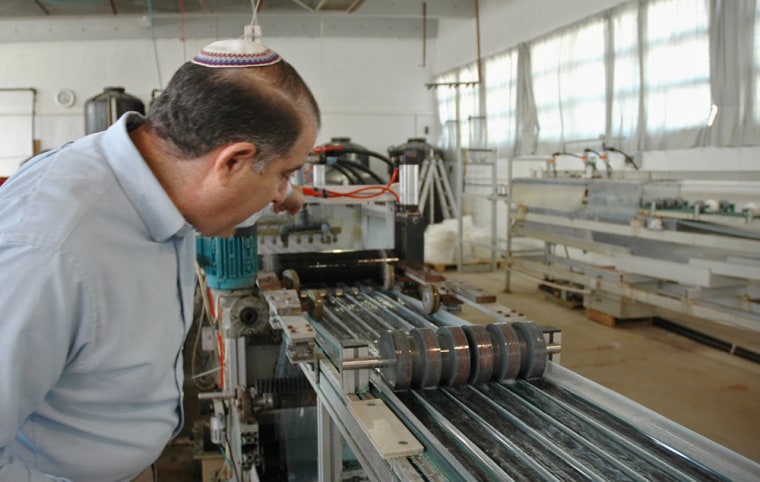Jeffrey Gabbay hasn’t washed his sports socks since 2004. He says he doesn’t have to.
Gabbay’s company, Cupron Inc., says it is the first textile manufacturer to produce fibers “impregnated” with copper oxide, an agent that kills bacteria and odor on contact. The socks, which he says can heal and prevent athlete’s foot, are one of his company’s best-selling products.
“Basically what I do is play golf, take off the socks, roll ’em up, put them in my shoes and I’ve been doing it for two and half years now,” Gabbay said. “I’m not trying to encourage unhygienic habits, I do it simply because I want to see how far we can go.”
Cupron’s self-sterilizing goods — including hypoallergenic makeup brushes and bed sheets — are part of the burgeoning market of “performance” textiles, which are enjoying strong sales at major retail stores throughout the U.S. and Europe. Cupron counts the U.S. military and one of the world’s biggest sock makers among its customers.
Its next goal is for the medical world to take notice. Gabbay, who has a background in textile engineering and biochemistry, believes textiles containing tiny copper particles can heal diabetic ulcers, prevent the spread of diseases in hospitals, and cure a host of other ailments.
While Gabbay points to strong anecdotal evidence, his claims haven’t been verified by rigorous scientific tests. For now, medical experts are skeptical.
“Some copper compounds are anti-bacterial, but that does not mean copper-containing compounds put in socks will necessarily be good,” said Dr. Gerald Weissmann, director of the Biotechnology Study Center at New York University.
Belief in copper’s healing qualities goes back thousands of years. The ancient Egyptians and Greeks used copper pipes to clean drinking water and the Aztecs used it for sore throats. Today, many arthritis sufferers wear copper bracelets to relieve their pain.
But Weissmann said copper’s history, like most metals, is largely mystical. “Very often claims of copper, especially in arthritis, have been shown to be pure quackery.”
Undeterred by such criticism, Cupron claims to be the first to bind copper oxide compounds to textile fibers.
The socks were the first commercial product released by Cupron, a 6-year-old company based in Greenboro, N.C. that conducts its research and development in the Jerusalem suburb of Beit Shemesh. Gabbay is a dual U.S.-Israeli citizen.
Experts say the market for anti-bacterial fabric has great potential, but competitors abound, particularly those who use silver, which also has anti-bacterial qualities.
“The interest in antimicrobials, especially antiviral coating, is very, very high,” said A. Blanton Godfrey, dean of the North Carolina State University College of Textiles in Raleigh. “Whoever gets it right will have a very nice business.”
Gabbay acknowledged his silver-based competition, but said copper’s future is much brighter. He said silver pollutes the environment and is also dangerous to humans, who metabolize copper, but not silver.
Companies are buying into Gabbay’s sales pitch. Cupron has signed a contract with North Carolina sock giant Renfro Corp., which developed its “copper-sole” brand using Cupron’s patented technology. The U.S. Marine Corps is trying the socks on new recruits, and Gabbay donated socks to Israeli troops during last summer’s war against Hezbollah guerrillas.
Gabbay said his company had a loss of $1 million last year and is expected to break even this year. He declined to provide specific sales figures, saying only that revenue is expected to exceed $10 million next year.
Even as sales rise, Gabbay is most excited by independent research that reveals unforeseen medical benefits of copper oxide.
Trial testing, for example, has shown Cupron socks have helped heal diabetic ulcers.
Richard C. Zatcoff, a podiatrist in South Carolina who has tested Cupron socks, said they cured 56 patients of athlete’s foot and led to better healing of diabetic ulcers than similar silver products.
“All I can report are anecdotal studies from my office,” he said. “But I think it’s a very exciting technology for the future.”
Gabbay also said Cupron bed sheets and pillowcases have been shown to help close bed sores, prevent acne and fix other skin disorders.
Gabbay has developed a line of medical goods — including surgical masks and gauze — but the products are on hold while the company seeks approval from the U.S. Food and Drug Administration. He is currently investing in clinical trials to win medical credibility.
“(Cupron) has interesting ideas and the world is hungry for new ideas that work,” said Dr. William Schaffner, chairman of the department of Preventive Medicine at Vanderbilt University Medical School. “But relatively few survive the rigor of first-rate medical investigation.”
